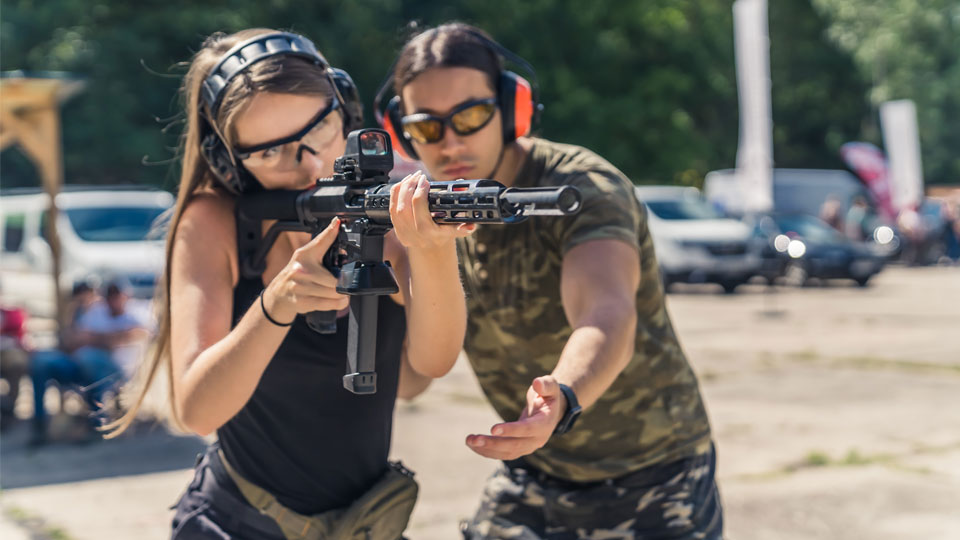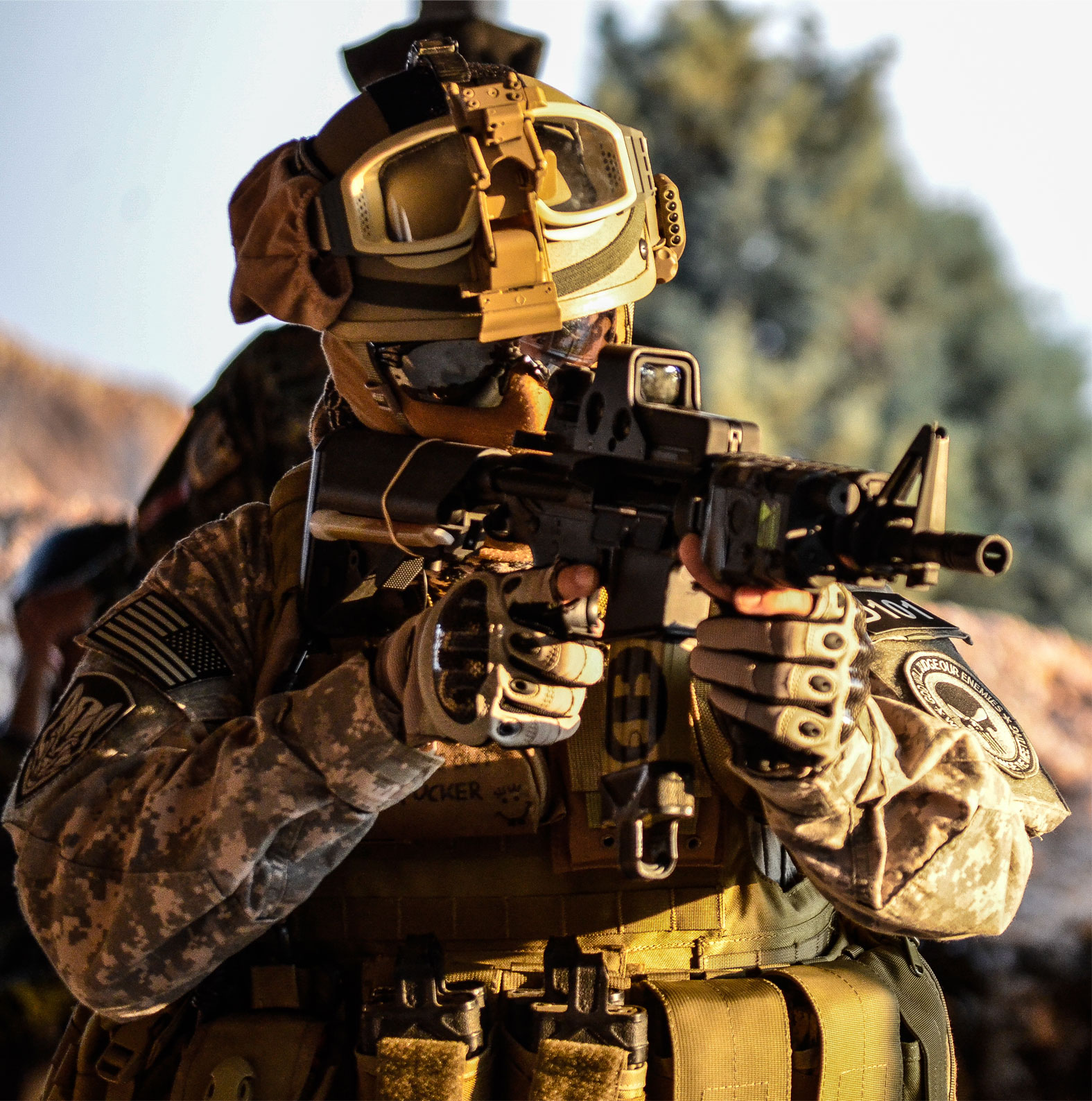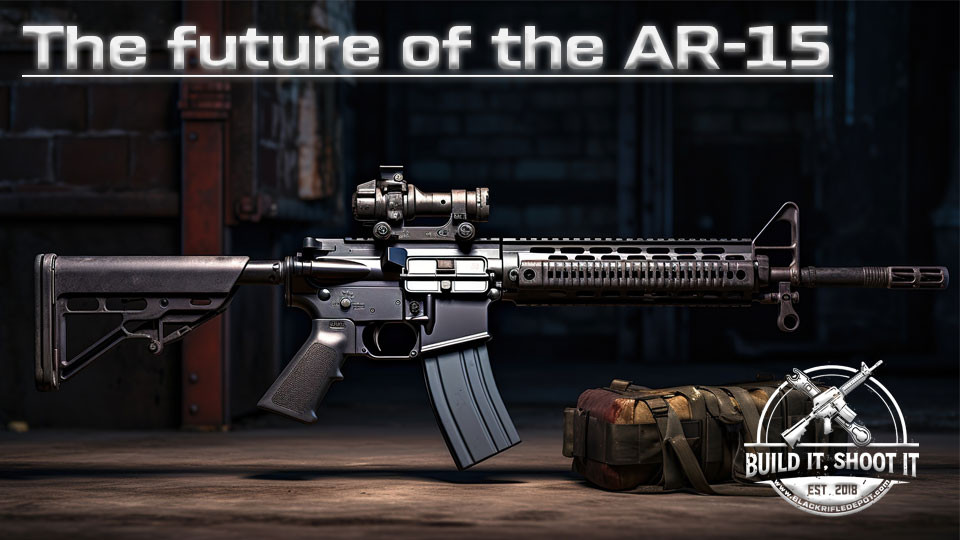The future of the AR-15
The future of the AR-15
The AR-15, born from the innovative mind of Eugene Stoner in the late 1950s, has journeyed from military realms to  Civilian hands are becoming both a symbol of personal freedom and contentious debate. This exploration, titled “The Future of the AR-15,” unravels the multifaceted existence of this firearm, delving into its historical lineage, technological evolution, sporting applications, legislative landscape, military utility, and market dynamics.
Civilian hands are becoming both a symbol of personal freedom and contentious debate. This exploration, titled “The Future of the AR-15,” unravels the multifaceted existence of this firearm, delving into its historical lineage, technological evolution, sporting applications, legislative landscape, military utility, and market dynamics.
We'll travel back to its inception, understanding the revolutionary design principles that have marked its history with innovation and controversy. By exploring its transformative technological advancements, we'll show how they've shaped its varied applications, from competitive shooting to self-defense.
We will navigate the dense terrain of laws and regulations, examining their impact on AR-15’s accessibility and societal implications. A look into its enduring relevance in military and law enforcement will reveal its tactical evolution and potential future developments. Lastly, insights into market trends and consumer demand will illuminate the ongoing evolution of the AR-15 in response to societal needs and market forces.
This compact exploration aims to offer a balanced perspective on the AR-15’s future, traversing its diverse domains and implications in a world constantly reshaping its relationship with firearms.
Historical Context of the AR-15
The AR-15 holds a unique place in the tapestry of American firearm history. Conceived by Eugene Stoner in the late 1950s as part of the Armalite company, the AR-15 was initially designed to fulfill military needs, seeking to replace heavier, less efficient firearms of that time. Stoner’s design was revolutionary, focusing on lightweight materials and allowing for effective gas operation—a stark contrast to the prevailing firearm designs, which were heavier.
The original AR-15 design sought to combine firepower with precision and maneuverability, a response to the evolving requirements of modern warfare. It was first introduced to military trials in the late 1950s but wasn’t immediately adopted. Eventually, in the early 1960s, a modified version was accepted as the M16 rifle and became a standard issue for U.S. troops during the Vietnam War. Despite early reliability issues, modifications and improvements transformed it into a dependable firearm, synonymous with the U.S. military.

However, the AR-15’s journey didn’t end in military landscapes. It traversed the lines between military and civilian domains, becoming popular among gun enthusiasts, sports shooters, and those seeking firearms for self-defense. Its semi-automatic civilian version maintained the modular design, allowing for extensive customization, a feature that attracted a broad spectrum of users. The adaptability, precision, and relatively easy handling made it a staple in the civilian firearms market.
The AR-15’s history is not without controversy. Given its use in high-profile mass shootings, it has been central to numerous debates and polarizing opinions on gun rights and public safety. The firearm’s effectiveness and accessibility have raised questions about the ethical implications of civilian ownership of military-grade weaponry. This has led to an ongoing societal dialogue, with proponents advocating for the right to bear arms and opponents pushing for stricter gun control measures.
Its historical significance also shapes firearm legislation and public perception of gun ownership. It became a symbol in the enduring debate over the Second Amendment, encapsulating the tensions between individual rights and collective safety. The AR-15’s prominence in discussions around gun laws has made it a recurring figure in legislative proposals, reflecting the societal struggle to balance freedom with responsibility in the context of firearm accessibility.
This iconic firearm has also played a pivotal role in the evolution of gun culture in the United States. Its portrayal in media, popularity among gun enthusiasts, and presence in public discourse have contributed to its iconic status. The AR-15 represents a blend of American individualism, self-reliance, and the enduring spirit of innovation while also constantly reminding us of the ongoing debates over gun violence and public safety.
The multifaceted history of the AR-15 is a tapestry woven with innovation, adaptation, and controversy. It symbolizes a profound evolution in firearm technology and design principles, illustrating a seamless transition from military applications to civilian utilization. This iconic firearm is a testament to the interplay between military needs and civilian desires, marking significant firearm development and use shifts. Its enduring presence has catalyzed intense discussions surrounding gun rights, ethical considerations, and public safety. Beyond its mechanical existence, the AR-15 epitomizes the complex interrelationship between societal values, technological advancement, and firearm culture, symbolizing the ongoing dialogue and tension surrounding individual freedoms and collective security.
Advancements in AR-15 Technology
The AR-15, since its inception, has undergone a continual evolution in technology, with improvements in AR-15 parts and accessories driving its adaptability and performance to new heights. This iterative development has been fueled by the ongoing pursuit for perfection among gun enthusiasts, manufacturers, and military tacticians, creating a dynamic innovation ecosystem.

Modularity and Customization
One of the defining advancements in AR-15 technology is its modular design, allowing for unparalleled customization. Owners can modify and replace various AR-15 parts, adapting the firearm to specific needs, preferences, and applications. This modularity facilitates the integration of a plethora of AR-15 accessories, including optics, grips, and stocks, enhancing functionality and user experience.
Material Innovation
Advancements in materials have played a crucial role in the evolution of the AR-15. Lightweight, durable alloys and polymers have replaced heavier, traditional materials, contributing to the firearm’s renowned versatility and maneuverability. These material innovations have reduced the overall weight and improved the longevity and reliability of AR-15 parts, enhancing performance across diverse environments.
Precision and Accuracy
Continuous barrel design and ammunition improvements have significantly improved the AR-15's accuracy and range. Integrating advanced rifling techniques and precision-engineered barrels has allowed tighter shot groupings and enhanced stability. Furthermore, the availability of high-quality, consistent ammunition contributes to the overall enhancement of shooting precision, catering to the needs of competitive shooters and sharpshooters.
Accessory Ecosystem
The ever-expanding market of AR-15 accessories offers users various options to optimize their firearms. From advanced optic systems, which provide superior targeting and sighting capabilities, to ergonomic grips and adjustable stocks, which improve handling and comfort, the accessory ecosystem enriches the AR-15's adaptability. Additionally, the advent of sound suppressors and muzzle devices has enhanced shooting experiences by reducing noise, recoil, and muzzle rise.
Enhanced Reliability
The ongoing refinement of internal components, such as the bolt carrier group and gas system, has increased reliability and reduced maintenance requirements. Enhanced coatings, superior metallurgy, and innovative design modifications have mitigated wear, corrosion, and fouling issues, ensuring consistent, dependable performance even under strenuous conditions.
Technological Integration
The embrace of modern technology has ushered the AR-15 into a new era of capabilities. Integrating electronic systems, such as intelligent scopes and ballistic computers, allows users to leverage data and automation for improved shot placement and environmental adjustment. These technologies augment the shooter's abilities, offering real-time insights and adjustments, optimizing the shooting trajectory, and compensating for external factors like wind and elevation.
The continuous advancements in AR-15 parts and AR-15 accessories have propelled this iconic firearm into the future, expanding its applications and elevating its performance. The amalgamation of modularity, material innovations, precision enhancements, a rich accessory ecosystem, improved reliability, and technological integrations has reinforced the AR-15’s status as a versatile, adaptable, and efficient firearm catering to diverse users, from hobbyists to professional sharpshooters. The symbiosis of tradition and innovation within the AR-15 realm continues to push the boundaries, reshaping the firearms landscape and the perceptions and experiences of its users.
AR-15 in Competitive Shooting and Sports
The AR-15 has earned a distinctive reputation in competitive shooting and sports, marked by its unparalleled precision, adaptability, and performance. Within the competitive circles, it’s not just a firearm; it's a symbol of accuracy and customizable excellence, enabling enthusiasts and professional sharpshooters to explore and showcase their shooting prowess to the fullest.
The AR-15’s advanced design and technological adaptations have proven invaluable in competitive shooting, where precision and speed are paramount. The superior accuracy, coupled with minimized recoil, empowers shooters with enhanced control and focus, essential components in competitions where the difference between winning and losing can be razor-thin. The meticulous design enhancements, state-of-the-art barrel technology, and high-quality ammunition have allowed the AR-15 to meet and exceed the rigorous demands of various competitive formats.
Its extraordinary customization capabilities amplify the AR-15’s appeal in the sporting domain. Competitors can tailor their AR-15s with an extensive range of calibers, accessories, and parts, fine-tuning their firearms to meet the specific demands of diverse shooting disciplines, from rapid-fire events to long-range precision shooting. This customization allows competitors to mold the AR-15 to their unique preferences and competitive requirements, maximizing efficiency and comfort.

Beyond its technical prowess, the AR-15 has found acceptance and admiration across a spectrum of shooting disciplines, showcasing its versatile capabilities. It has become a staple in competitions ranging from dynamic 3-Gun events to precision-based shooting competitions. Its universal applicability and adaptability have made it a favorite, resonating with the diverse dynamics inherent in different shooting sports.
The significant presence of the AR-15 in competitive shooting has also fostered a vibrant, passionate community of novices, experts, and enthusiasts. This community is a melting pot of innovation, knowledge sharing, and mutual respect, where individuals can cultivate their skills, share their experiences, and pursue excellence in their shooting endeavors. The camaraderie and the shared passion within this community have solidified the AR-15’s iconic status in the shooting sports world.
Pursuing perfection in competitive shooting propels ongoing innovations and refinements in AR-15 technology. The future is poised to witness the emergence of even more advanced and refined models, augmented with cutting-edge technological integrations, setting new standards in competitive shooting. Continued developments in materials, optics, and other accessories are anticipated to elevate the competitive shooting experience further, unlocking new possibilities and challenges for enthusiasts.
The AR-15, with its blend of precision, versatility, and customizable excellence, continues to be a symbol of aspiration and achievement in the world of competitive shooting and sports. Its enduring appeal and influence are reflections of its technological superiority and testimonies to the vibrant community and culture that have embraced it. As the landscape of competitive shooting continues to evolve, the relationship between the AR-15 and its enthusiasts is destined to grow, representing a harmonious fusion of passion, technology, and sporting spirit.
Legislation and Regulation
The legislative and regulatory landscape surrounding the AR-15 is a complex and continually evolving tapestry, reflecting the societal, political, and ethical dynamics inherent in firearm ownership and usage. The AR-15, often at the center of national debates over gun control due to its association with several high-profile mass shootings, has become a symbol in the ongoing discussion about balancing individual rights with public safety.
Gun control advocates argue for stringent regulations on AR-15 ownership, citing the potential for misuse and the devastating impact these firearms can have when they fall into the wrong hands. Proposals often include stricter background checks, mandatory waiting periods, and outright bans on specific models or accessories deemed unnecessary or excessively dangerous in civilian hands. The AR-15’s capability for rapid fire and its modifiability make it a focal point for those who advocate for tighter controls on firearm accessibility.

Conversely, gun rights proponents see the AR-15 as emblematic of individual freedoms protected by the Second Amendment. To them, owning such firearms is a constitutional right, integral to self-defense and resistance to potential tyranny. They argue that responsible, law-abiding citizens should not have their rights curtailed due to the actions of a few individuals. Legislative attempts to restrict access to the AR-15 are perceived as encroachments on individual liberties, sparking spirited debates about the essence and limits of constitutional rights.
The polarized perspectives on AR-15 regulation have spurred many state and federal legislation, ranging from permissive to restrictive. Some states maintain lenient stances, allowing residents considerable freedom in owning and modifying AR-15s, while others have enacted stringent laws, imposing significant restrictions on acquiring, possessing, and changing such firearms. This patchwork of regulations creates a diverse and sometimes conflicting array of legal landscapes that AR-15 owners must navigate.
Amidst this legislative milieu, court battles and legal challenges are commonplace as stakeholders on both sides of the debate seek to assert their interpretations of constitutional rights and public safety imperatives. Legal precedents, constitutional arrangements, and legislative nuances intertwine, shaping the legal frameworks that govern AR-15 ownership and usage. The multifaceted legal discourse surrounding the AR-15 reflects broader societal dialogues about values, freedoms, and the role of government in regulating individual behavior.
Internationally, the regulatory approach to firearms like the AR-15 varies widely, with many countries imposing strict controls or outright bans. This reflects different cultural attitudes toward guns and divergent philosophies on individual rights and societal safety. The international variance in firearm regulation provides contrasting perspectives and fuels discussions on the efficacy and ethical implications of different regulatory models.
In this legislative and regulatory labyrinth, the AR-15 stands as a complex symbol, embodying the tension between liberty and security, individualism and collectivism. The ongoing debates, legal battles, and legislative developments surrounding this firearm indicate the intricate interplay of values, rights, and responsibilities in contemporary society. As societal attitudes, legal interpretations, and political landscapes evolve, so will the discussions and legislation surrounding the AR-15, reflecting the dynamic nature of the relationship between society and firearms.
AR-15 in Military and Law Enforcement
The AR-15 has roots deeply embedded in military history. Its derivatives and adaptations extend its presence into law enforcement agencies, symbolizing tactical efficiency and adaptability. Incorporating the AR-15 and its variations in these sectors highlights its significance in modern combat and security operations, underlining its impact on tactical methodologies and operational dynamics.
Military Application
Initially developed for military utilization, the AR-15's architecture was built to address the evolving requirements of warfare. Its lightweight design, accuracy, and adaptability made it a preferable alternative to the heavier, less versatile firearms of its time. Its initial adaptations, notably the M16 and M4 Carbine, have been extensively used by the U.S. military and other armed forces worldwide. The continuous refinements and modifications in design, materials, and accessories have enhanced its reliability, performance, and versatility in diverse combat environments.

Evolution in Tactics
The AR-15’s introduction marked a shift in military tactics, emphasizing mobility, precision, and adaptability. Its design accommodated the needs of both conventional and unconventional warfare, allowing for effective engagement in varied combat scenarios. The AR-15 and its derivatives facilitated the development of new tactical doctrines, influencing the dynamics of individual and unit-level arrangements and altering the paradigms of combat strategy.
Law Enforcement Integration
In law enforcement, the AR-15 is a versatile tool that addresses the diverse challenges of maintaining public safety and order. It's adaptability and modularity allow law enforcement agencies to tailor the firearm to the specific needs of various operational contexts, ranging from urban policing to specialized tactical units. Integrating advanced optics, accessory systems, and less-lethal attachments enhances the functional capabilities of law enforcement personnel, enabling precise and measured responses in high-pressure situations.
Balancing Power and Responsibility
Incorporating the AR-15 in law enforcement also raises questions of power, responsibility, and the ethical use of force. The firearm’s capabilities necessitate rigorous training, discipline, and accountability to ensure its judicious use in law enforcement contexts. The discussions surrounding the AR-15 in law enforcement reflect the broader debates on police militarization, use of force protocols, and community relations, emphasizing the need for balanced, responsible deployment of such advanced weaponry.
Continuous Innovation
The quest for tactical superiority continues to drive innovations in the AR-15’s design, materials, and accessory ecosystem in military and law enforcement domains. The evolving operational requirements and technological advancements propel the development of more refined, reliable, and capable AR-15 variants. Integrating new technologies, such as intelligent scopes, ballistic computers, and advanced communication systems, further augments the AR-15’s contributions to military and law enforcement operations.
The enduring presence of the AR-15 in military and law enforcement signifies its adaptability and the pivotal role it plays in shaping tactical approaches and operational outcomes. Its continuous evolution is intertwined with the advancements in tactical doctrines, ethical considerations, and the relentless pursuit of operational excellence in both sectors. The journey of the AR-15 from its military origins to its widespread adoption in law enforcement illustrates the multifaceted impacts of this iconic firearm on the strategies, methodologies, and discussions in the spheres of combat and public safety.
Market Trends and Consumer Demand
The AR-15 occupies a dynamic space in the firearm market, representing a convergence of consumer demand, innovation, and market trends. The fluctuating market dynamics are influenced by myriad factors, including legislative changes, societal attitudes, and advancements in firearm technology, which shape consumer preferences and purchasing behaviors.
Evolving Consumer Preferences
The demand for AR-15s is driven by a desire for customization, versatility, and performance. The AR-15's modular design caters to these preferences, allowing owners to tailor their firearms to their needs and tastes. This demand for personalization has driven manufacturers to offer many options and accessories, enabling users to modify everything from barrels to stocks, reflecting individual usage requirements and aesthetic preferences.
Innovation and Technological Advancements
Continuous innovations and technological advancements in the firearm industry significantly influence market trends. Introducing new materials, design modifications, and accessory integrations have enhanced the performance, reliability, and user experience of the AR-15, attracting a diverse consumer base. Advancements in optics, intelligent technologies, and accessory ecosystems have enriched the AR-15's functionalities, making it a preferred choice for enthusiasts looking for state-of-the-art firearm solutions.
Legislative Impact
The legislative landscape is also pivotal in shaping market trends and consumer demand for the AR-15. Changes in gun laws and regulations can impact the availability, pricing, and purchasing conditions for AR-15s, influencing consumer decisions and market dynamics. Stricter regulations can lead to surges in demand due to anticipated restrictions, while lenient laws can expand the consumer base by allowing more accessible access to such firearms.
Economic Factors
Economic conditions and pricing strategies significantly impact consumer demand and market trends for AR-15s. Price elasticity, influenced by manufacturing costs, taxation, and import-export conditions, can affect consumer purchasing power and market penetration. Manufacturers and retailers adopt varied pricing models to navigate economic fluctuations and cater to different consumer segments, balancing affordability with quality and features.
Market Segmentation and Demographics
The market for AR-15s is diverse and segmented by different user demographics and usage patterns. The versatile nature of the AR-15 appeals to a wide range of consumers, from sport shooting enthusiasts and hunters to individuals seeking firearms for self-defense. Market strategies are often tailored to address different consumer segments' specific needs, preferences, and spending capacities, optimizing product offerings and marketing approaches to resonate with target demographics.
Future Trends
The future of the AR-15 market is likely to witness the amalgamation of cutting-edge technologies, evolving consumer preferences, and dynamic legislative environments. Emerging technologies such as 3D printing and intelligent integrations are poised to reshape manufacturing paradigms and product functionalities, creating new opportunities and challenges in the market. The interplay between consumer demands, innovation trajectories, and regulatory frameworks will continue to sculpt the market landscape, dictating the availability, diversity, and progression of AR-15 offerings.
The market trends and consumer demand for the AR-15 result from complex interactions between innovation, legislation, economics, and consumer preferences. This intricate matrix defines the commercial journey of the AR-15, from production to acquisition, reflecting the multifaceted nature of its existence in the societal and commercial fabric. The continuous evolution of market dynamics and consumer behaviors will shape the trajectory of the AR-15, mirroring the transformative journey of this iconic firearm in the ever-evolving firearm marketplace.
Conclusion: Insights into the AR-15's Journey
The journey of the AR-15 is a multifaceted narrative, interweaving technological innovation, societal implications, legal considerations, and market dynamics. From its initial conception as a military firearm to its widespread adoption and diversification into civilian, law enforcement, and sporting domains, the AR-15 has remained a symbol of adaptability and controversy. Its modular design and technological advancements have facilitated customization and enhanced performance, meeting diverse needs and preferences.
The AR-15 stands at the convergence of debates surrounding individual rights, public safety, and societal values, reflecting the complexities inherent in balancing freedom with responsibility. The legislative landscape surrounding it continually evolves, shaped by shifting societal attitudes and legal interpretations.
Innovation, legislative changes, economic conditions, and consumer preferences shape market trends and consumer demand for the AR-15, reflecting the dynamic interplay of various forces in shaping its commercial journey.
In synthesizing insights into the AR-15’s journey, we observe a firearm that is not just a piece of machinery but a living artifact, embodying the intricate relationships and ongoing dialogues between society, technology, law, and individual rights.
Recent Posts
-
Best AR-15 Handguards - MOE SL Handguard
In the world of AR-15 customization, handguards not only protect the barrel but are pivotal in enhan …Feb 5th 2025 -
Budget vs. Premium AR-15 Rifle Scopes: Are Expensive Optics Worth It?
When it comes to enhancing your AR-15's performance, selecting the right AR-15 rifle scope is crucia …Feb 2nd 2025 -
Top Lightweight Red Dot Sights for Minimalist AR-15 Builds
Choosing the right red dot sight for your AR-15 is more than just picking a well-known brand—i …Jan 30th 2025





